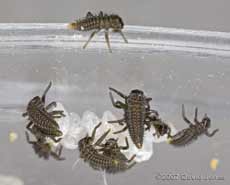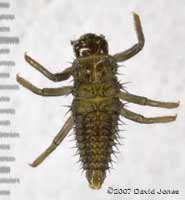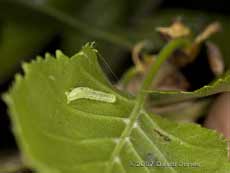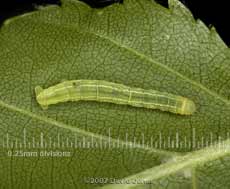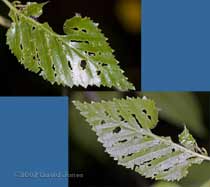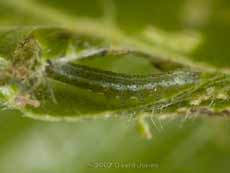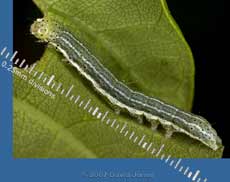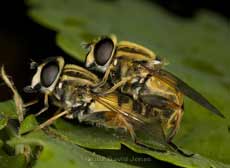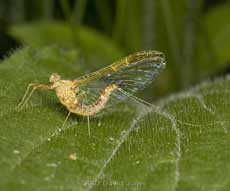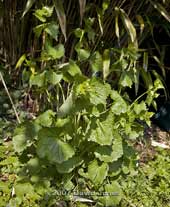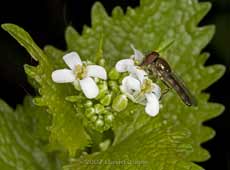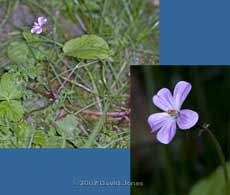Go to the last entry on this page .....Go to previous entry20 April - The sunshine continues, with another dry day in prospect.
It was busy seeking out aphids, and it has a small one in its jaws in this picture.
This is the earliest it has flowered since I started the garden diary in 2001, although looking back over those six years hardly suggests any pattern forming, the first flowering days for 2001-2006 being 13 May, 22 April, 24 April, 9 May, 1 May, and 11 May.
22 April - The dry, mild weather continues, and today it reached 21C this afternoon.
Back on the 7th, I photographed a female Misumena vatia spider that has captured a bee from its ambush position in a dandelion flower. Today, for the first time I had the chance to photograph a male of the same species. Quite a bit smaller that the female, it also looks quite different, with the dark areas on its body and front legs, and easily mistaken as a spider of a completely different species.
Measuring over 7mm in length, and looking so much like a large version of a four-spot melanic variation of a 2-Spot Ladybird, it would be so easy to regard as a very pretty addition to the garden fauna if you didn't know what it really is!
The second Harlequin, equally large is a typical specimen with the classic black spots on the red background - on the right in this picture. The left-hand ladybird is the one that I photographed on the 16th and which is causing me an identification problem. As this picture suggests, it is much smaller than the obvious Harlequin specimens that I have collected in the garden. It continues to be kept in captivity, with a regular supply of aphids while I try to establish its identity. A final Harlequin note - On the 19th, I photographed the eggs laid by one of the harlequins caught that day. My intention was to keep them until they hatched. Unfortunately, I didn't remove the adult from the container and a few hours later she ate them! However, she has since redeemed herself my laying another group yesterday. These are now safely secured so that they can develop without becoming a meal.
Going back to the 'good' ladybirds, I thought I'd include this picture of a 2-Spot Ladybird larva having lunch!
24 April - A cool and largely cloudy day with the temperature creeping up to just over 19C, three degrees warmer than yesterday when we resorted to lighting the fire for the first time in a couple of weeks! Yesterday we even saw a bit of rain, although it was hardly enough to settle the dust.
Yesterday also saw the opening of the first Ragged Robin flower of the year, with several more opening today.
Today, the Wild Garlic (Ramson) opened its first flowers, deep under the Hawthorn. I also see that the Three-cornered Leeks have their spiky flowerbuds now, so they should be opening in the near future.
Another two Harlequin Ladybirds turned up today, both the typical spotted variant. Taken into captivity, one almost immediately started mating with one caught yesterday, and the other laid another batch of eggs, so I will have plenty to watch as the larvae hatch out.
Talking of eggs, On the big bamboo by the workshop shed I had already marked (yesterday) one leaf that had a group of yellow ladybird eggs (probably 2-spots again). Today I found a second, smaller group of deeper coloured eggs.
A close look revealed that the new eggs, as well as being more orange, are also very slightly taller and with a rather more pointed top end. They must be a different species, and based on the mating pairs that I've seen on the plant, I wonder if they could be the eggs of 10-Spot Ladybirds - I shall have to wait for another set of larvae to emerge.
The last two days' cooler conditions have certainly had an effect on native ladybird numbers seen, today I saw just a few 2-Spots and this richly coloured Cream-Spot Ladybird, here photographed indoors before being put back where it was found. I don't remember noticing previously how hairy the face is.
Notice how its underside and legs are the same orange-brown colour.
This afternoon I've been listening to, and watching the Wrens again. This time I saw one taking a feather into the nest. According to my bird books it is the female that does this after she has chosen the nest. If that is the case it will be absolutely brilliant. I shall be paying special attention from now on. The Robins were engaging courtship feeding again - I can't decide if they have nested in the Ivy tree this time.
25 April - A few drops of rain, but otherwise a fine if quite cloudy day.
First of all, another flower, although I think that this one actually flowered yesterday and I missed it. It's the first Three-cornered Leek of the year, and appears to be at least a few days ahead of the rest. As well as pretty flowers, these plants have a strong aroma which you cannot miss in the garden, even if you have hay-fever!
Another ladybird picture - this time (I think!) a spotless 10-Spot Ladybird.
It seems that the presence of the white triangle just outside the base of the middle legs is a distinguishing mark of 10-Spot Ladybirds.
An update on the eggs I photographed yesterday - the yellow ones have hatched out, and it seems that the darker ones have been eaten! While on the ladybird topic, there were no Harlequins seen today, and I'm beginning to see ladybird larvae (not Harlequin) wandering about the bamboo leaves as more and more eggs hatch out.
However, they don't have the aphids to themselves. As well as the Lacewing larvae (photographed on the 20th), I also come across hoverfly larvae such as this one which has hoisted a still alive aphid clear of the leaf surface as it prepares to tuck into a meal.
I've started making new bee hotels from pieces of old, well seasoned timber. The new generation of Osmia bees is going to need more of the large (7mm) holes, and with many still sealed from last year, accommodation is limited!
As well as these larger bees being active, we are starting to see activity around the smaller, 3mm holes as well. Although I didn't actually see mating occur, this pair remained together for several minutes before the female disappeared into a hole,
and this is a male resting at the side of the log the holes are drilled in. I haven't had time to look up what species it is.
Another hole on the log was being visited by this bee (which may be another male of the same species), seen feeding on a Dandelion.
It was only when the bee returned to the log that I could take a closer look at what was on its head. I cannot really make it out, but it looks very much like a fungal growth of some sort, rather than something that the bee has 'picked up' accidentally.
To end today on a bright note - a colourful, if rather small moth which was resting on the side of the same log. Seen here previously in August 2005, I think it is a Pyrausta aurata, a micro-moth, sometimes known as the mint moth as mint plants (growing well in and around my big pond!) are the food plants for its larvae.
26 April - A bright morning turned into a cloudy afternoon with just a sprinkling of rain.
And during the brightness of the morning we had an all too rare treat when this Buzzard spent a couple of minutes soaring high up, and almost directly above us.
On a negative note, another Harlequin was caught this afternoon, this time another H. axyridis spectabilis variant. The problematic individual that I photographed on the 16th and 18th is now on its way to Peter Brown of the Ladybird Survey Project for a closer look, and I hope to get a definitive ID in the near future. I've seen several Birch Shieldbugs on the big bamboo plant over the last few days but not had the chance to photograph them, and today, while standing on top of my shed to check the top of the plant for Harlequins I found this Parent Bug, still in what, according to 'Shieldbugs of Surrey' is still in its hibernation colours. It wasn't possible to take its photograph in situ so I brought it indoors to take these pictures. While the ringflash has somewhat hidden its colouring, it has helped to emphasise the textured nature of the insect's exoskeleton.
This ventral view shows a much paler range of colours, including the blue-green rim along the sides of its body.
30 April - As we come to the warmest April on record, the rain continues to stay away, and I have been finding the CFS a bit frustrating, to put it mildly. So a bit of catching up needs to be done, although some will probably have to wait until tomorrow. Fits of all, before I forget, something I would have loved to be showing you a photograph of - the first Hornet queen that I have ever seen. I had a camera in my hand, but fitted with the wrong lens when the hornet appeared down our West Wing. There was no doubt about it as it was well over an inch in length and made even the worker hornets that sometimes visit look very small.
The Harlequins continue to arrive. None today, but three yesterday, and two of those started mating as soon a put together in a container, and the third laid eggs.
This group of larvae hatched last night, having been laid on the 20/21 April, so it takes eight days from egg-laying for these little monsters to be released into the environment.
They already show the spiky appearance characteristic of the older larvae. I suppose it's only a matter of time before I spot the first larva in the garden. At least now I know what to look for.
While they are yet to appear, the native ladybird larvae are appearing all over the bamboos now, and this morning I found these two tucking into ladybird eggs - even our native species are not beyond a bit of cannibalism. I haven't identified these yet.
Two bits of good ladybird news - there was a pair of Cream-spot ladybirds mating in the bamboo today, so with a bit of luck we'll get some of their offspring before too late, and I saw an Orange Ladybird in the Birch for the first time this year. The Birch leaves also yielded a couple of caterpillars.
The first, measuring just under 1cm, was under a leaf, relatively out in the open apart from a thin framework of silk which pulled the leaf into a gentle curve -
and a closer look.
The second caterpillar was largely hidden from sight beneath a folder corner of this well nibbled leaf (bottom -right in the lower image).
This was the clearest view that I could get of the caterpillar itself.
My little Oak tree in a pot also has a caterpillar which, like the previous pair needs some work to identify it.
Just a few leaves away, this pair of hoverflies were busy mating, and hardly noticed as my camera lens moved closer and closer to them.
Yesterday, I spotted this mayfly, possibly Chloeon dipterum, a species that only has two wings and can even be found breeding in water butts. I saw another one today.
A new plant in the garden this year is this Garlic Mustard (Jack-by-the-hedge (Alliaria petiolata). Not related to the Garlic plants that grow here, the Garlic Mustard gats its name from the fact that it gives of a small of garlic when you rub a leaf between your fingers, and it contains mustard oil.
Its small, white flowers started opening over the last two days.
Another plant that started flowering yesterday is this Herb-Robert (Geranium robertianum) plant. The plant, on the slope up to the West Wing, is a result of self-seeding as the plant is several yards away from the original plant which was put in under the big bamboo by the workshop shed.
Click on images to see larger versions |
|
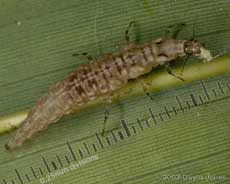
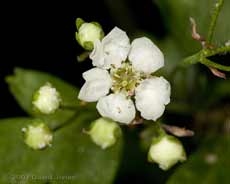
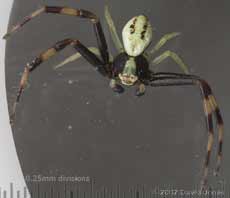
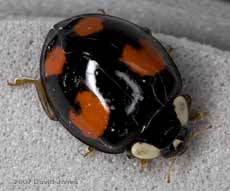
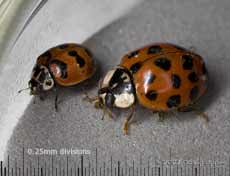
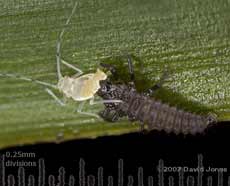
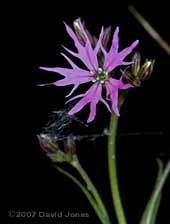
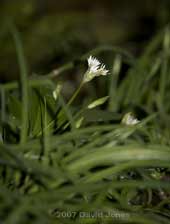
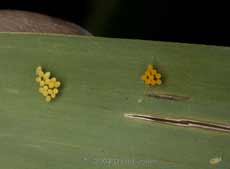
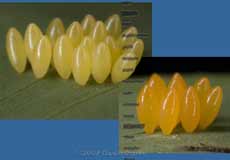
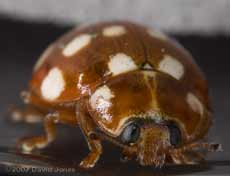
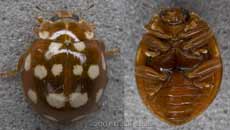
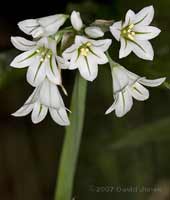
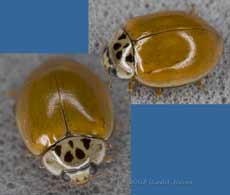
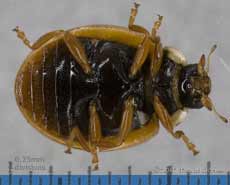
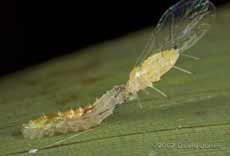
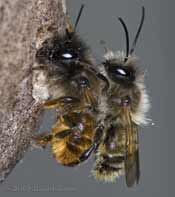
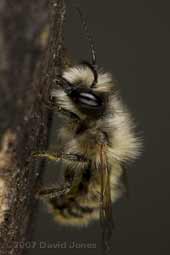
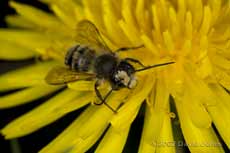
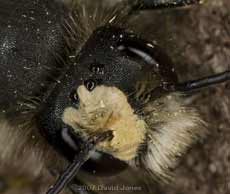
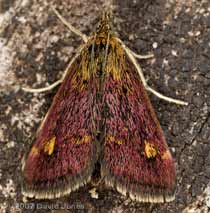
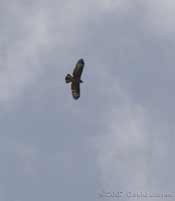
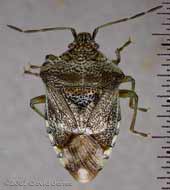
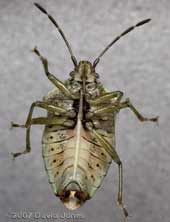
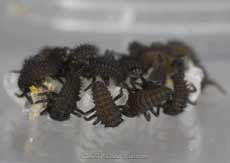 A
group of Harlequin eggs laid (in captivity) on 22 April hatched today.
A
group of Harlequin eggs laid (in captivity) on 22 April hatched today.
